|
Monday, November 17, 2008
Progress Notes
A couple of weeks ago I wrote about the Robinett family of the Brumley/Ulman area, and in particular Omer Robinett (photo 01), who had given me a banjo in the early 1960’s which I recently donated to the museum.
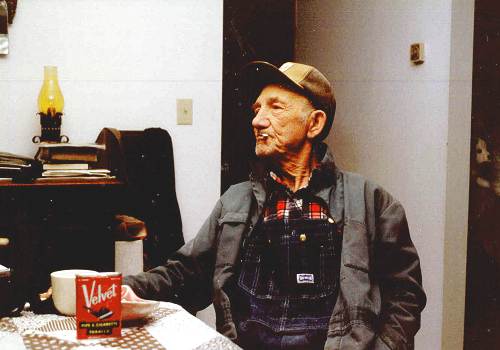
01 Omer Robinett
I had mentioned that I thought Omer was a very intelligent man who had the gift of a near photographic memory, especially in regard to recalling the details of his Robinett family history going all the way back to the family’s origin in France in the 17th Century.
Recently, I received a letter from Lois (Mace) Webb (photo 02) with some very interesting additional detail about Omer, whom she knew very well early on in her life since her family’s farm was next to that of Omer’s in the Brumley area near what is now called Twin Bridges Road.
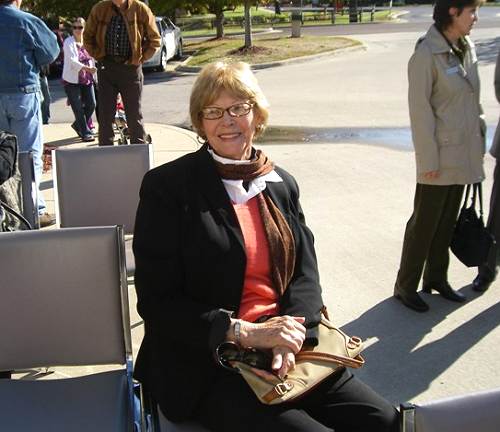
02 Lois Webb
Lois is the sister of Lee Mace and I most recently had visited with her at the honorary ceremony in Osage Beach three weeks ago which honored Lee by dedicating to him a section of Highway 54 giving it the name of “THE LEE MACE MEMORIAL HIGHWAY” (photo 03).
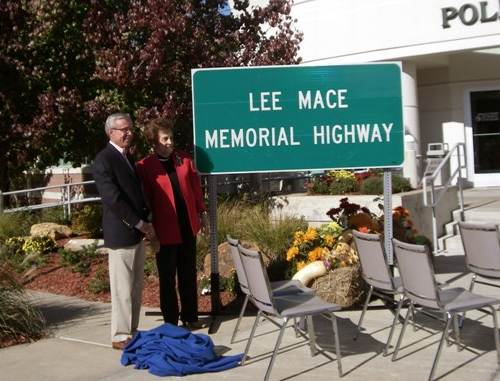
03 Gene Williams and Joyce Mace by Uncovered Road Sign
Lois left Miller County early in life and moved to Johnson County, Kansas. While there she not only led a family life raising her son, Dave Webb (who by the way was the master of ceremony at the highway dedication in Osage Beach) but also took advantage of several educational opportunities, most especially earning a BA in Liberal Arts; an MS in the School of Journalism; and an MA in Communication Studies, all from the University of Kansas. In addition she also earned a Doctor of Chiropractic, and later graduated from Unity School of Religious and Ministerial Studies becoming an ordained Unity Minister.
I mention her extensive résumé because it gives credence to her comments I copy below regarding her thoughts not only about Omer Robinett but also about the Chiropractor, Dr. T.F. Thompson, who was discussed in a second part of Progress Notes for that week (3 November 2008).
Below is copied Lois’s letter:
The Robinetts’ have always held a special place in my heart; likewise with Lee Mace, my brother. We moved from Brumley when I was 10, so many of my early memories include the Robinett(e) family. Our farms joined. Lee was 12, so he had even more memories of them.
First, though, an aside. A very nice coincidence regarding the Robinett family occurred with me last week. I called a woman at Bucyrus (Kansas), Christie Cannon, because her name was given me having to do with house cleaning. She's coming here in a few days. We knew several local people in common and then I asked of her name -- Cannon. I told her that a dear friend I knew named Cannon, who formerly lived around Holliday, Kansas or Bonner Springs area, died about a year ago at the home of a granddaughter out East somewhere. Christie shouted – “You're talking about Marjorie, my husband's grandmother. Marjorie Robinett married a man named Cannon, who lived in KC, when she was a very young woman!” Tears literally filled my eyes. I had saved Marjorie's obit and wept as I read it again. She was very dear to our family. Yes, she might have been called a hired girl -- she stayed with us in Brumley during the few years that mom taught school after Lee and I were school-age. But she was far more than the hired girl. She loved Lee and me perhaps more than if we were her own and you can be sure we thought there was no one in the world like Marjorie. And she welcomed living at our house because -- well, there were quite a number of siblings living in their small house. Marjorie kept her good outfit at our house where she "got ready" to go somewhere. Oh I think of so many little incidents and of her smiling face. She was a dear. On occasion, especially through mom's later years, I usually took mom to the Brumley School Reunion, and a few times, Marjorie was there. We truly had a bond of more-than-friendship.
And then there's Omer. I hold him so dear too. I often sought him out at those reunions and many times we pulled our chairs off to the side and talked. Well, he talked and I listened. I scarcely understood most of what he said but believed it was important. There would often be a point when the conversation got too -- what? -- esoteric? and I felt it safer to steer it back to something like growing tobacco and drying the leaves for chewing. Or hogs. But I treasured those times with him. I have far more memories than I'll take the time to share here, but here are snippets:
First, my aunt Ollie (Mace) was in his class in Brumley High School. Ollie always said Omer was smarter than all the rest of the class, teachers and all, put together. Ollie always held ill will toward the teachers because they didn't acknowledge Omer's brilliance; rather they catered to the children of merchants or people with more so called social standing than Omer. Ollie never cut the teachers any slack for what she called unfairness to Omer. So, you can tell that Ollie was always a good press agent for Omer. He could do no wrong in her eyes.
Another story: Long after Lee was established as Mr. Ozark Opry, (and as you know, Lee never forgot his roots) Omer was in the then-fairly-new Lake Hospital. Lee went to see him. The man in the bed next to Omer said with some astonishment – “do you know this man?” Omer said, “Hell yes I know him, my own mammy nursed him when he was a baby!” And that is true. Lee had serious digestive problems as an infant; mom's milk, or any other, didn't agree. Cynthia Robinett was nursing her own infant, Oren, and since Lee and Oren were only a few months difference in age, Cynthia nursed Lee too. Mom said she finally ordered a product widely advertised at the time for digestion in babies -- she added the powdered product to the milk and Lee immediately recovered. I've seen old magazine ads for the product.
I happened to be in Miller County when Omer died. I was so grateful to be there because I don't think it would have occurred to mom to phone me. Mom and I went to his service in Ulman. The minister really hadn’t known Omer. His routine talk didn't do Omer justice as far as I was concerned, so when we passed by the casket on the way out, I said to the young man: I suppose you know you have officiated at the service of not only a good man, but a great man. He stuttered a bit and agreed. Then, as mom and I walked to the gravesite for the committal, we noticed the minister was ready but waited for us to get close before he said his final words. He then made up for what I thought he missed at the church -- about Omer's unusual mind, his innovative concepts -- stuff like that. I had to smile, and said to mom -- perhaps he thought I'd scold him if he didn't acknowledge Omer more appropriately.
I have kept a file on Omer, still have his obit; I also have a picture of his gravestone with his "formula" engraved on it. Omer talked to me about the “formula.” I had written several pages of my memories and thoughts about Omer -- journal type things just so I wouldn't forget the occasion of knowing him. But in particular now, I would like to discuss the “formula” more; do you have a take on it? It’s LM (law of motion) equals an equation -- some fraction to some power. I think it comes out to zero, but I don't know that for sure. Jack Wyrick said when we saw it on his tombstone that he didn't figure Omer had a calculator and that it would have likely taken him a month -- that is a work-week month full of hours -- just to figure that out on paper (and Jack was a computer expert, very mathematically oriented). In one of mine and Omer's talks, in reference to something, he paused to spit tobacco juice, then said: “Hell, that's just that old Euclidian geometry -- hell, I've knowed that stuff forever.” Later at KU Library, I looked up a book on that old Euclidian geometry. I couldn't get through page one.
A number of years later after that time (which was in the 1950’s), Omer told me that he had occasion to speak to a professor at MU (I figure through Donald) about his equation. My notes indicate that the professor showed him published papers from the university about Omer’s particular set of calculations, and Omer told me he had done it all right except for one step in the whole. Then Omer said: “You know what it was? Hell, it was that damn Laser beam -- I just missed it by one step in the calculation!"
Omer's talk often was far beyond my comprehension; still, I have books on my shelf by Michio Kaku (he autographed one, Parallel Worlds, when I heard him lecture on it); by Stephen Hawking about his string theory and a few years ago I attended a lecture by an astronomer who, among other information, shared the fact that it was Einstein's first wife who arrived at E=MC(2).
I've seen the info verified since. I say this to say that while I do not comprehend these things, I have a fascination of sorts with them, and do "get" measures of overall concepts. I have another book called PI in the Sky -- about numbers, mathematical truths, etc. Again, I don't "get it" but it fascinates me. I always believed there was so much more information available than authority figures ever either understood, or bothered to tell the unwashed! I've held Omer in something of an expanded dimension of thinking; he likely understood some universal principles most of the rest of us -- even most intellectuals -- could not comprehend.
I may be wrong and if so, that's okay because I've cherished my fantasy. His siblings and peers may have not cared that much about the equation, but I want someone younger than me to be mindful that his equation exists. I just don’t want someone down the road to pick up a Nobel Prize for the same thing that's carved in stone at the Robinett(e) Cemetery at Brumley! I think it's a hoot. See why I enjoy my fantasy!
The day of Omer’s funeral, during a tearful and meaningful visit with Omer’s son, Don, I asked him a little about the equation. I said I didn't understand it, but always felt it was important -- a little like looking at the pyramids which, standing in impish silence, challenge onlookers to figure them out. Don said, oh sure, there will be people who will figure out the mathematics of it, but they'll not know what it means. It wasn't the time for us to talk more about it, but we both shared knowing it was important. Don and his wife, Jan, both revered Omer, as did his two grandchildren, high-school age (photo 06).
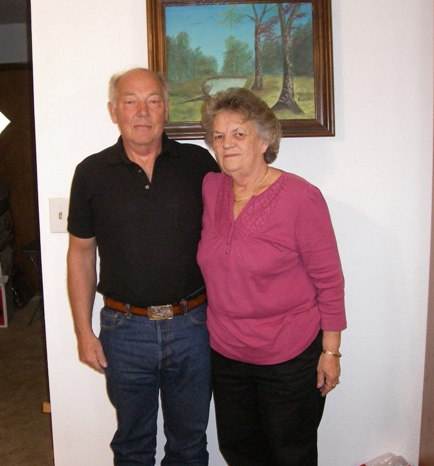
06 Donald and Jan Robinette
Omer's dad, Herman (photo 07), was indeed a good fiddle player.
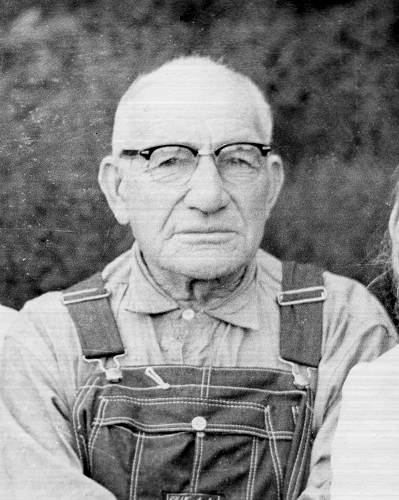
07 Herman Robinett - Father of Omer
Mom (Clare Mace) had a nice fiddle and it was not uncommon for fiddle players in the community to come to play mom's fiddle. And people danced, either on the front porch in summertime or in the living room in winter. Mom had a Martin fiddle -- made back when the Martin Company, famous for guitars, made fiddles. We never knew for sure how mom's fiddle disappeared, but it did. It was not uncommon to loan instruments for someone to play a dance. And I doubt that mom even knew the value of her fiddle at the time, except that it was a good one.
That aside, I recall Herman and several of the kids being at our house on any number of occasions and we listened while Herman played the fiddle. My private focus was in watching mom's demeanor while Herman rested the body of the fiddle on the bib of his overalls, and held the bow a quarter of the way up, his fingers not even close to proper position. I figured any minute mom would scold him, as she did Lee and me if we held the fiddle improperly. Not so. She sat back like every one else, patted her foot and enjoyed the fiddle tunes. Those memories remain vivid in my mind. I often said that mom never told us about proper use of silverware, but we'd jolly well better know how to hold a fiddle!
So glad Omer gave you the banjo and that you kept it. Another example of Omer's insight!
Lee and dad (Lucian Mace) could recite a rhyme, a riddle in fact, that was passed to the Robinett family, as I recall the story, through Herman's father, Hiram, for whom Herman's son Hiram was named. I wish I could recite the verse though I never did commit it to memory as did dad and Lee. It contained some kind of a mystical riddle about a treasure buried somewhere on our farm and clues were given. I do recall several people through the years -- a dozen perhaps -- who came to our house and asked permission, which we gave, to search our farm for a hidden treasure. They entered the fields and wooded areas with shovels and perhaps binoculars. Dad always joked about it. He believed the rhyme, or riddle, implied that the treasure was hidden within oneself and required diligent search.
Well, perhaps I've finally run down. So glad you're into the Robinett(e) story. I have a thing about unsung heroes, and Omer was one of those in my world. I have truly felt, perhaps a misplaced sense of responsibility about Omar's equation. I have not known anyone outside his family who would take an interest in it; be mindful that it exists, while at the same time, have an ear tuned to the more exotic branches of science. I'm most grateful for your interest.
Thanks Lois.
I was intrigued by Lois’s statement above about an “equation” on Omer’s tombstone. I had taken a photo of the tombstone which I put on the website a couple of weeks ago along with the story of Omer and the Robinett family, but I didn’t remember any equation on the stone. I became so curious about it that I went back the other day to look more closely at the tombstone, and by golly there it was in the lower left corner. “LM = (1/8) to the eighth power” (photo 08).
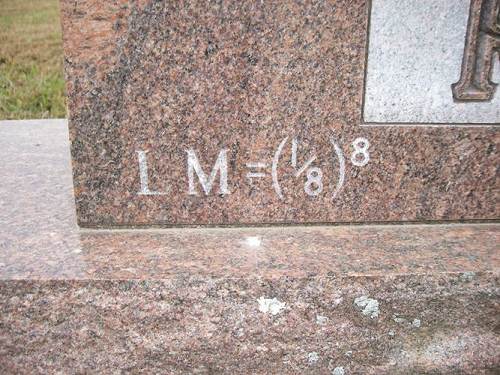
08 Equation on Omer Robinett's Tombstone
I spoke with Brian Robinett, son of Donald (who was out of town last week on vacation and couldn’t be reached), to ask him about his grandfather, Omer. Brian was familiar with Omer’s work on the equation and said he and his grandfather, Omer, had talked about it frequently. Brian said he thought Omer was a mathematical genius and that Omer thought the equation was the basis of all laws of motion. Brian also said that Omer had taught him enough mathematics before he started school at Osage that he ace’d most math tests he ever took. Brian told me that he was so interested in math that he became bored with other aspects of school so took and passed the GED test, after which he entered college directly skipping the rest of high school.
Lois, who as I mentioned above is a trained Chiropractor, was interested in the second story I included in the Progress Notes of two weeks ago concerning the lady with chronic hiccups, Norma Jones. So I copy below Lois’s comments about Norma:
Another subject: Of course I took smiling satisfaction in the story about the chiropractor in Tuscumbia "curing" the lady's hiccups. I had not known there was ever a chiropractor in Tuscumbia, much less that he roomed with your grandparents (Madison and Sadie Bear)! Interesting. I was reminded of my early days in Chiropractic College, the early 1960s, when Dr. Carl Cleveland told us that Chiropractic had a reputation for curing hiccups. First of all, he said, always remember that Chiropractic does not cure anything; it only attempts to free interference to the nerve impulse, and if the Chiropractor can do that, the body will ordinarily cure itself of the ailment. So with hiccups, and he went on to tell us the ramifications of the phrenic nerve, arising primarily from the 4th cervical, and with branches passing through and even under the diaphragm, etc., and, in effect, that hiccups could be one symptom of interference to nerve impulses, and that those symptoms usually ceased when interference was removed so that the phrenic nerve could freely do its job. That's not verbatim, of course, but you get the point. When I hear someone with hiccups to this day, I think 4th cervical, or phrenic nerve, internal respiratory nerve of Bell, interference! Does medicine acknowledge that yet?
Thanks again, Lois.
Last week I began a short series of articles by the old Steamboat Captain, Henry Castrop (photo 09).
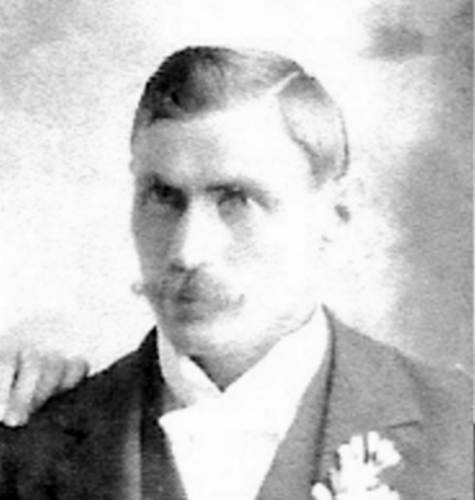
09 Henry Castrop
I will continue this week with another article written by Captain Castrop for the Tuscumbia Autogram which was part of a series he wrote for the paper about the old steamboat days. The article this week is about Governor Joseph McClurg, who was a steamboat owner and captain after serving earlier as Missouri governor and later as U.S. representative for Missouri in Washington D.C. (photo 10).
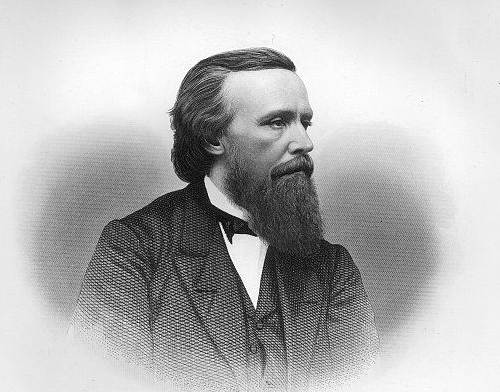
10 Joseph Washington McClurg
Before copying Captain Castrop’s article I first will copy here a short biography of Governor McClurg:
Joseph Washington McClurg was born in Missouri in 1818 but at the death of his parents returned to Ohio. He was educated at Oxford, Ohio, then taught school in Louisiana and Mississippi. In 1839 he moved to Texas where he studied law and was clerk of the circuit court in 1840. He returned to Missouri and married Mary C. Johnson (c. 1819-1861) in l841. They were the parents of eight children. Joseph W. McClurg was a prominent merchant at Linn Creek, Missouri, prior to the Civil War. He represented Missouri in Congress for three terms, then was drafted into the governorship of Missouri, serving from 1869 to 1871. He was an intensely religious man, as most of his writings reflect. While he was in Washington D.C., rebel raiders destroyed his store in Linn Creek, causing financial reversals from which he never recovered. Upon leaving public office in 1871 McClurg entered into several business ventures with his sons-in-law, including lead prospecting, mining and smelting operations, and the building and operation of the Emma, a steamboat. McClurg's daughter Emma married Marshall W. Johnson. Johnson was open to many business ventures proposed by his father-in-law and also entered into partnership with Charles Draper. Johnson and Charlie Draper were partners in an unsuccessful farm and orchard.
And now Captain Castrop’s article for the Autogram. As I mentioned last week, at the time these articles were written, the plight of Black Americans had little improved since the Civil War, and they suffered many abuses and atrocities in those post war days, including demeaning personal references. However, for historical accuracy I am copying the article as originally written:
Governor Joseph McClurg: His Boat “Steamer Emma” Plied From Osage City to Linn Creek
By Captain Henry Castrop
Tuscumbia Autogram circa mid 1930’s
Again the “nigger” whistle sounded, a sign that the boat had discharged the freight she had for this place. A negro deck hand untied the bow line and while others were rolling it up on a reel under the second deck the steamer moved slowly from its moorings into the channel on another 50 mile journey to its destination…Linn Creek.
It is not my aim to sketch all the sceneries, shoals and landmarks as I have done this from the mouth to Tuscumbia, although they would merit. Suffice it to say that on this, the upper Osage, the shoals are still more numerous and some of them even more difficult to pass over by the navigator than those on the lower river. The Brockman, the Houser and the Big and Little Kenchlows are among those most dreaded by the pilot. This upper Osage has also its beautiful sceneries. The bluffs are somewhat different as they shape to more artistic resemblances as the Devil’s Armchair and the Lover’s Leap (photo 11) which, with bases of huge rock, protrude closely to the water’s edge.
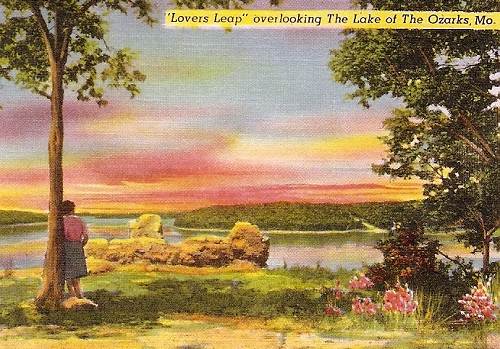
11 Lovers Leap
Bagnell, 12 miles above Tuscumbia, is the terminus of the Bagnell branch of the Missouri Pacific railroad. This station is the shipping point for Linn Creek and intermediate towns. Most of the tie rafts from the upper Osage were landed here and the ties loaded on board cars (photo 12).
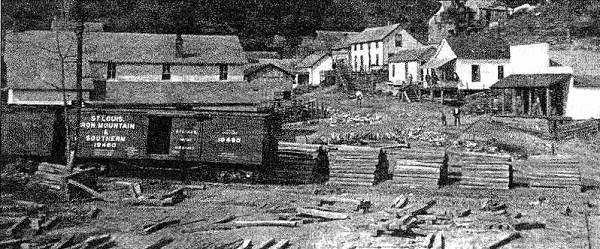
12 Bagnell Tie Yard
As the boat proceeded further, the bends of the river became sharper and the stream narrower, while the bur oak, white oak and black oak, the walnut and hickory predominate, we also find the gum tree of huge dimension one hundred miles above the mouth while the pecan becomes extinct a few miles above Tuscumbia.
“This is Governor McClurg’s mansion...” Captain Dodd, with whom I was in the pilot house, said as he called my attention to a house on the bluff, “and right above this shoal (the Linn Creek) is Linn Creek.” The steamer now blew her landing whistle. The mighty voice was carried for miles over hills and valleys, making known to the inhabitants its presence at their port.
While the steamer is landed at the wharf, Linn Creek itself being located nearly a mile inland, the river front is crowded with people to view the boat. The businessmen appear to settle their freight bills, numerous dray wagons draw up to haul the freight from the wharf and deliver to the boat such produce as the merchants may have to ship to the St. Louis market on the down trip as eggs, hides, etc. Wheat in those days was not grown to any extent in Camden or Morgan counties for the reason of bad shipping facilities or, which is more probable, because of the contentment of the American farmer with his cornbread and bacon. The European farmer was very scarcely represented or had not invaded this part of the Ozarks at all. A closer description of Linn Creek, the seat of Camden County, may follow later.
Captain Dodd was one of the pilots, who with some of the older ones, among them captain William Towns and Captain C.A. Rubey, had advanced further up the Osage in prior days, Warsaw, in Benton, Osceola, in St. Clair, and even Shell City, in Vernon County, were at times reached by large steamers which would sometimes venture even further up to the head of navigation. These boats were obliged to lower their smokestacks for the overhanging tree tops and had to proceed with utmost caution as snags protruding above and more numerous ones hidden under the water, were encountered. These boats were also in danger of being left high and dry by a sudden fall of the waters. This was actually the fate of one of them which did not become afloat until many months after.
Within a few hundred yards above Linn Creek landing the Niangua River empties its waters into the Osage.
The Niangua tributary of the Osage, at its mouth, is nearly as large as the Osage itself. Not far from the mouth of this river is located Hahatonka park, the most beautiful in the Ozarks (photo 14).
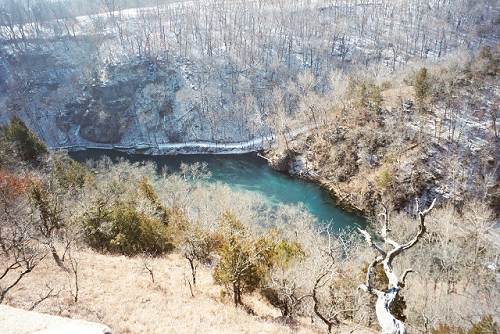
14 Ha Ha Tonka Spring
Around the turn of the century (1900) a large stone home was built (photo 15).

15 Ha Ha Tonka Castle after Fire
As the “Far West” had swung around for the down trip, I will finish describing the Osage by naming the creeks of importance which, below Linn Creek, poured their waters into this river as we pass them. Linn Creek, Auglaize, and Bear creeks above Tuscumbia; then the Saline, Humphrey’s Big Tavern, Little Tavern, Sugar Creek, Bois Bruhle, Indian Creek, Prophet’s Creek, Rock Creek, Big Maries and Cadet Creek. A beautiful lake above Painted Rock created by walling up the mouth of a hollow with a concrete dam by the Jefferson City Hunting Club is deserving of mention.
Soon after this trip the opportunity of viewing the river again as far as St. Elizabeth was offered. On his trip up and down the river Governor McClurg had noticed the large sign put on the full length of the warehouse Westphalia landing No. 7 in three colors. Landing there at one time, I was asked by him the name of the artist. To this query I had to name my humble self. He insisted that I adorn the pilot house of the “Emma,” which lettering was so weather-beaten and dim that it was no longer discernible, with new letters. I consented, but said: “Governor, you must not expect a job as done by the brush of an expert. I am no expert in sign painting.”
“No expert,” the Governor retorted, “I never in my life saw anything more artistic than this sign.” I went on board the “Emma” and before the governor came out of his cabin to where he had retired to take his afternoon nap, the job was done…and done to his satisfaction.
Having no more to do, my time was mostly spent on the hurricane deck in conversation with the governor, a plain but pleasant old gentleman of small stature. The frocktail coat and stovepipe hat, his common appearance, gave him much the appearance of a “Reverend,” which title, had he been ordained as such, would have been very fitting, as he was a very conscientious and pious man who never willfully would trespass against any of the ten commandments. The “Emma,” on Saturday night at midnight, would be tied up to the bank no matter where she was and the lines were not untied until the 24 hours of the Lord ’s Day had passed. Sunday was spent by the governor reading the Bible.
One of the historical subjects which interest me is the music which evolves along with the culture of a group of people over a couple of centuries of time. I am most interested in those elements of the musical culture which remains pure and free of significant outside influence. For that reason I enjoy listening and participating in musical activities which have their origins in the hill country of the Ozarks region. So it was that some time ago I spent an afternoon with Clifford and Pat Hill (photo 16) at their home in Eldon.
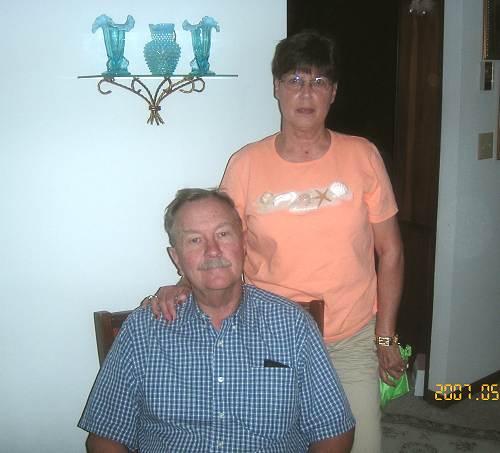
16 Clifford and Pat Hill
Clifford was raised on a very picturesque farm located in the valley of the old Tuscumbia Versailles road about a mile or so north of the Osage River. In fact, his house was almost due west of my house which was built on top of the hill along Highway 52. I used to walk through the woods through the Arthur Edwards farm to visit the Hills’ as a child. Their home was so warm and loving because of the goodness and special gifts of Sophie Hill, Clilfford’s mother. She was a poet, song writer, musician and singer who was gifted with great wisdom as well. Clifford and his siblings were taught the old literature and the old music which Sophie knew and loved. It was only natural that Clifford would in time learn to play the fiddle and the old time music which were played in homes and gatherings throughout the hills of Miller County over the last two hundred years, even today in some places. So the day I visited Clifford played some of the old time music on his fiddle while I “seconded” on the guitar.
Clifford has played semi professionally with local groups, most frequently with Harold Rowden’s blue grass band; but he has played for square dances and loves to play the old waltzes (photo 16a).
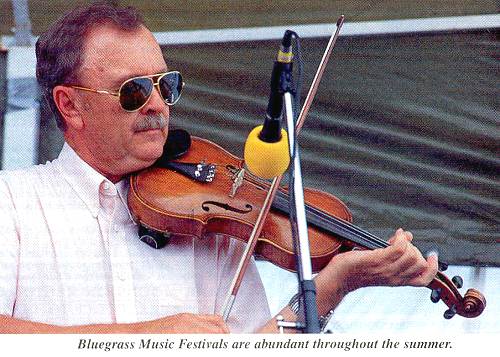
16a Clifford Hill playing at a Bluegrass Festival
He knows his fiddle intimately having disassembled it and reworked it until the sound was just right. He even took advantage of modern techniques using an electronic device to measure the tonal frequency difference between the backboard and the face of the fiddle to have the perfect balance between the two sides. Clifford is one of those gifted musicians who can bring his instrument to life and make music that absolutely cannot be imitated by digitalization from a computer. His early local influences included fiddlers such as Lyman Enloe, Henry Thompson, Junior Marriott, and Travis Inman.
The extended Hill family has always had some who had musical talent. A cousin of Clifford’s, Charles Hill, who unfortunately recently passed away, even played in Ray Price’s band at one time.
Clifford’s roots in Miller County originated well before the beginning of the last century on both his mother as well as his father’s side. His paternal great grandfather, Robert Field Hill (photo 17), who had three wives (he was a widower three times) and fourteen children came from Tennessee to Spring Garden, Miller County Missouri and fought in the Civil War for the North.
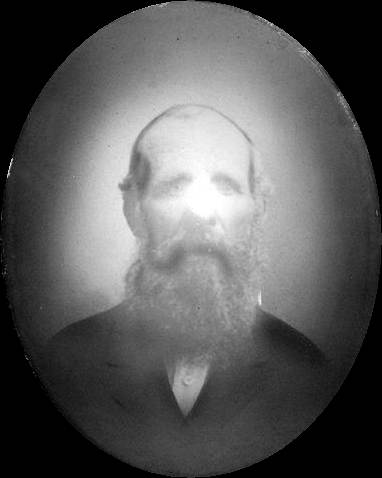
17 Robert Field Hill - Civil War Vet - Great Grandfather to Clifford Hill
His burial was in Spring Garden. Jesse Lafayette Hill (photo 18), the son of Robert, moved to a farm located one mile west of the Skinner Vault on Highway 52.
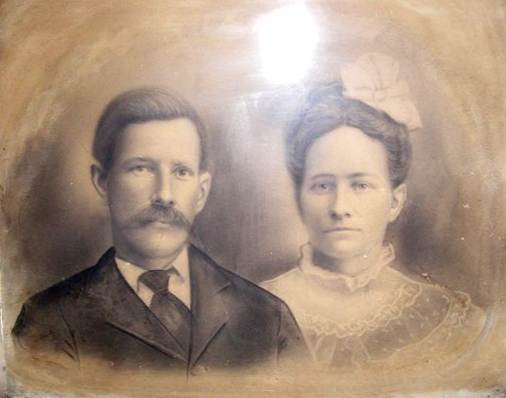
18 Jesse Lafayette Hill and Emma Thompson Hill - Sister to Corrie Thompson
It was on this farm where Clifford’s father, John, was born in a log cabin which is where Clifford was born as well.
Sophie, Clifford’s mother, was the granddaughter of a physician, Thomas Benton Wilson M.D. who came to Missouri from Indiana to practice medicine in Aurora Springs during the time it was considered to possess one of the world’s few healing springs. He built a new home there in 1882 which stood until fifteen years ago when unfortunately it was destroyed by fire. Dr. Wilson moved to Kansas after the public’s fascination with Aurora Springs abated. His son, and Sophie’s father, Ralph Wilson, lived in several areas in Kansas and Oklahoma and Sophie herself lived the early part of her life in the “Indian Nation” of Oklahoma. She wrote an autobiographical book about her life including many interesting stories about her early days in Oklahoma, a copy of which is in our Miller County Museum library. Eventually, Ralph Wilson moved to a farm near Riley’s Bluff on the Osage River when Sophie was seven years of age. She attended Harmony School of the Flatwoods area which is where she met John Hill, Clifford’s father.
Greenlee Thompson, one of Miller County’s early ministers of the gospel, was Clifford’s great grandfather (photo 19).
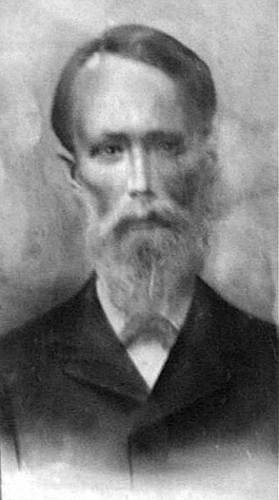
19 Greenlee Thomson - Great Grandfather to Clifford Hill
These days Clifford, who is semi retired, can be found often caring for and manicuring his home farm near Tuscumbia where he was born. When you pass by it, you will notice the picturesque gated entrance through which an attractively landscaped winding road leads to the original Hill home which is beautifully maintained. If you would like to hear Clifford play his fiddle, you often can find him playing with the musical group which entertains each Thursday at noon at the Senior Citizen’s Center in Eldon.
One of Clifford’s prize possessions are two paintings by the famous Miller County painter, John Wright (photos 20 and 21).
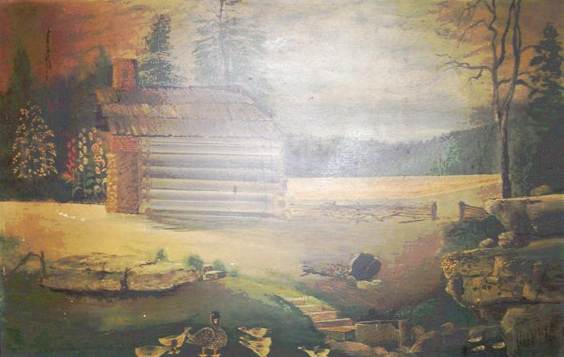
20 John Wright Painting
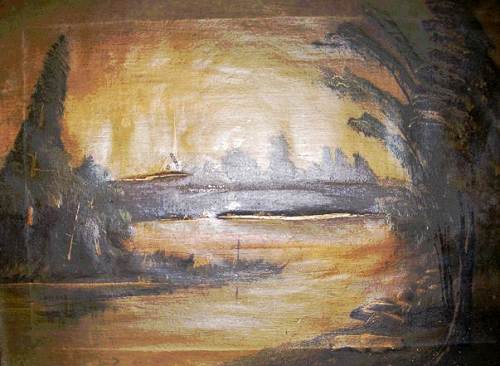
21 John Wright Painting
These paintings were given to Clifford Hill by Bryce Gene Smith several years ago and are very old. It was difficult to get a really good photograph of them. Bryce Gene had gotten them from his mother, Ida Wright Smith, who was a cousin of John Wright. Bryce Gene’s father was named Roy Smith. The family lived for many years on the Tuscumbia Versailles road just a couple of miles north of Tuscumbia and were close neighbors of the Hill family.
Another interesting family artifact in Clifford’s possession is an old quilt block (photo 22).
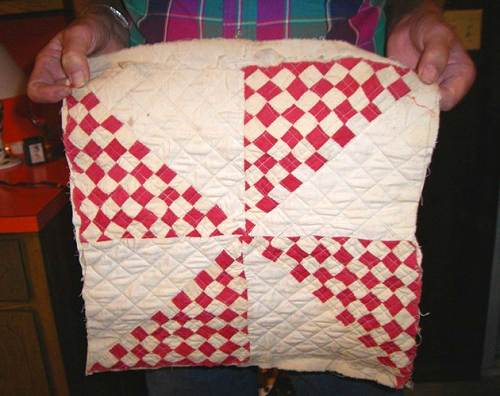
22 Quilt Block
The quilt block which is of the “Postage Stamp” design, was made many years ago before the Civil War when members of the Chittim family were coming south toward Miller County. The mother of the family, whose name Clifford did not remember, was his third great grandmother on his mother, Sophie’s side. The story goes that a baby was sleeping in a bassinet covered by quitlets such as the one pictured and that since it was very dry, the oxen pulling the wagon stampeded toward the Missouri River once they smelled water. The wagon was submerged but the father rescued the baby in the bassinet. The quiltlet pictured was one of those covering the baby.
Last spring, Clifford suffered a very traumatic accident involving a stump remover in which he eventually had to have his middle finger removed from the left hand. Many people, especially fiddle players who know how important this digit is for fingering the notes on the strings, doubted Clifford would ever play the fiddle again. For several weeks even Clifford had his doubts. But with the care of a very skilled hand surgeon, excellent physical therapist and most of all, Clifford’s determination, Clifford is now playing the fiddle once again and for the last several weeks has been performing in public. This is an amazing thing, as any fiddle player can attest, to be able to play the fiddle with the absence of the left middle finger!
That's all for this week.
|



